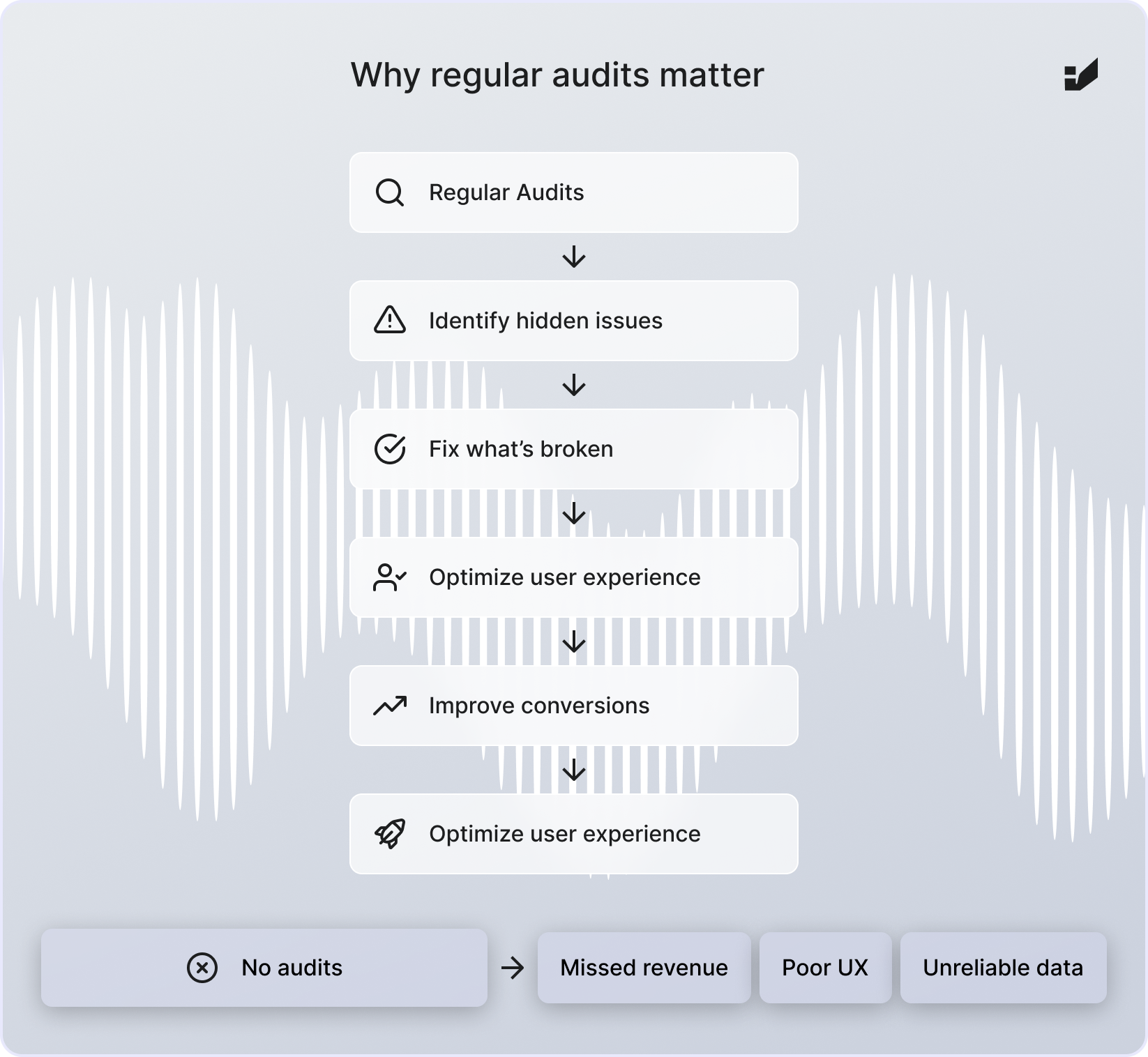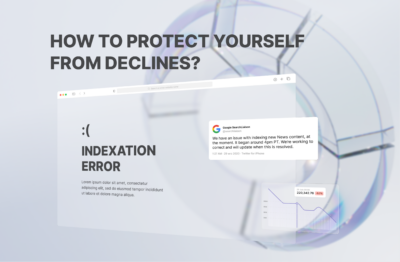The vital role of e-commerce analytics audits for online business growth
Data has become a core asset in e-commerce. The ability to collect, interpret, and act on insights from user behavior often determines whether a business grows or struggles. An e-commerce analytics audit plays a central role in turning raw numbers into useful insights.

It’s a detailed check-up that reveals how your store is performing, identifies areas for improvement, and highlights key areas for enhancement. When done properly, it offers a clear path toward better decisions, improved efficiency, and steady business growth.
Why e-commerce analytics audits matter
An e-commerce audit is like a full check-up for your online store. It helps reveal what’s working, what’s underperforming, and where you might need to take action. This review covers key areas such as website speed, user experience, SEO setup, and security. All of these have a direct impact on how well your store performs.
Doing audits regularly makes it easier to catch problems early, before they grow into something harder and more expensive to fix. It also gives you a clearer picture of your financial performance and how customers behave on your site. On top of that, it helps you see how your business compares to competitors.
But it’s not just about spotting weak points. A good audit can show you where there’s room to grow. It can uncover hidden opportunities and help you focus on areas with the most potential.
Without this kind of review, it’s easy to overlook key issues. Worse, you might end up making decisions based on incomplete or misleading data, and that can take your business in the wrong direction.
E-commerce website audit – what should it include?
An e-commerce website audit is a detailed checkup of your store’s performance. It looks at areas like speed, SEO, UX, content, and security. The goal is to spot weak points and give clear recommendations on how to fix them. If your online store isn’t converting as expected, this kind of audit will tell you why.

Here’s what a solid e-commerce audit should include:
1. Performance and Speed
Page speed directly affects conversions, SEO rankings, and user satisfaction. Shoppers don’t wait for slow pages to load, especially on mobile.
Check:
- Loading time on desktop and mobile
- Core Web Vitals (LCP, FID, CLS)
- Heavy assets (unoptimized images, unminified scripts)
- Server response time and caching setup
Use tools like Google PageSpeed Insights, GTmetrix, or WebPageTest to spot performance issues.
2. UX and Navigation
The site should be easy to navigate, intuitive to use, and optimized for conversion.
Key areas to review:
- Is the site structure clear and logical?
- Are product categories easy to browse?
- Is the search functionality fast and accurate?
- Are CTAs visible and persuasive?
- Is the checkout process smooth, or does it cause drop-offs?
Check both desktop and mobile usability. Test common user paths like product discovery, cart updates, and finalizing a purchase.
3. Content and SEO
Content drives traffic and influences buying decisions. SEO helps people find it.
Review:
- Product descriptions – Are they unique, helpful, and written in the right tone?
- Image quality – Are visuals sharp, consistent, and supported by alt text?
- Meta titles and descriptions – Are they optimized and clickable?
- Headings – Is the hierarchy (H1, H2, etc.) used correctly?
- URL structure – Is it clean, short, and keyword-friendly?
- Internal linking – Are related products or pages linked to support navigation and SEO?
Also, check for duplicate content, broken links, and proper use of canonical tags. Make sure your sitemap is up to date and your robots.txt file isn’t blocking important pages.
4. Security
Security builds trust and protects sensitive data. Even small shops need solid protection.
Assess:
- Is your SSL certificate valid and properly installed?
- Is customer data (especially payment info) encrypted and handled by trusted providers?
- Are admin panels protected by strong passwords and limited access?
- Is two-factor authentication enabled for logins?
- Are you using secure payment gateways (e.g., Stripe, PayPal)?
Run regular scans to detect vulnerabilities and outdated plugins or libraries.

5. Functionality
Everything on the site should work exactly as intended. Even small glitches can break the user experience or stop a sale.
Test:
- Add to cart and remove from cart functions
- Promo codes and discounts
- Product filters and sorting
- Contact forms, newsletter signups, and live chat
- Account creation and login/logout flows
Make sure all third-party integrations work smoothly, like CRMs, shipping providers, or review platforms.
6. Analytics Setup
You can’t improve what you can’t measure. That’s why analytics tracking must be correctly set up.
Verify:
- Is Google Analytics (or GA4) installed and working?
- Are e-commerce events tracked (e.g., add to cart, purchase, refund)?
- Are conversion goals configured?
- Is Google Search Console linked and active?
- Are heatmaps or behavior recordings used for UX insights?
If you’re running paid ads, make sure pixels (Meta, Google Ads, etc.) are firing correctly across the funnel.
To provide a clearer understanding of the scope, the following table outlines the key areas and elements of an e-commerce analytics audit:
| Category | Element | Description |
| Performance and Speed | Platform Functionality & Uptime | Ensure the e-commerce platform is functioning correctly and consistently available to users. |
| Security Features | Verify the implementation and effectiveness of security measures like MFA, data privacy protocols, and compliance with GDPR/PCI DSS. | |
| Server Configuration & Hosting Performance | Assess resource allocation, server modules, network settings, capacity planning, and hosting reliability for optimal efficiency. | |
| Website Speed & Caching | Analyze page load times and the implementation and utilization of server-side and client-side caching mechanisms. | |
| Mobile Responsiveness | Evaluate the website’s adaptability and performance across various devices and screen sizes. | |
| Technology Stack & Integrations | Review the platforms, software, SaaS licenses, integrations, and identify potential bugs in the code. | |
| UX and Navigation | Overall Design & Navigation | Assess the visual appeal, ease of navigation, and logical structure of the online store. |
| Mobile Responsiveness & Site Load Times | Evaluate the website’s performance and user experience on mobile devices and the speed at which pages load. | |
| Intuitiveness & First Impression | Determine how easily users can understand and interact with the site upon their initial visit. | |
| User Interaction & Usability Issues | Analyze how users engage with the site and identify any points of friction or difficulty in their experience. | |
| Checkout Process & Shopping Cart Functionality | Review the steps involved in completing a purchase and the features and usability of the shopping cart. | |
| Customer Service Aspects | Evaluate the accessibility and effectiveness of customer support resources and processes. | |
| Site Navigation Elements | Check the homepage, menus, breadcrumbs, categories, FAQs, and footers for clarity and ease of use. | |
| Content and SEO | Product Descriptions & Images | Review the quality, relevance, and SEO optimization of product descriptions and visual content. |
| Overall Website Content | Assess the relevance, quality, and SEO optimization of all text, images, and other media on the site. | |
| Technical SEO Audit | Examine XML sitemaps, robots.txt, response codes (00, xx, xx, xx), and canonical tags. | |
| On-Page SEO Elements | Evaluate meta tags, meta descriptions, keyword rankings, and overall alignment with SEO best practices. | |
| Broken Links & Duplicate Content | Identify and address any broken links or instances of duplicate content that could harm SEO. | |
| Mobile Usability | Ensure the website provides a seamless and effective experience for users on mobile devices. | |
| Product Description Consistency | Verify consistency in tone, style, and formatting across all product descriptions. | |
| Image Alt Attributes & Content Structure | Ensure all images have descriptive alt text and that the content is organized for readability and SEO. | |
| Security | Payment Gateways & Shipping Logistics | Evaluate the security of the processes for handling payments and managing the shipment of orders. |
| Security Audits | Conduct tests and reviews to identify vulnerabilities and potential sources of data leaks. | |
| Access Control, SSL, Firewalls, Backup | Examine the configurations and effectiveness of security mechanisms and disaster recovery plans. | |
| Data Protection Regulation Compliance | Verify adherence to relevant laws and standards such as GDPR. | |
| Functionality | Critical Feature Evaluation | Assess the effectiveness and usability of essential website features. |
| Product Search & Filtering | Analyze the speed and accuracy of the search function and the intuitiveness of filtering options. | |
| Checkout Process Analysis | Test the user journey from adding items to the cart to completing the purchase. | |
| Inventory Management Systems | Evaluate the accuracy and efficiency of systems used to track and manage product stock levels. | |
| Analytics Setup | Relevance, Accuracy, & Compliance | Verify that the existing analytics setup meets business needs, provides accurate data, and complies with privacy regulations. |
| Data Collection & Tracking Errors | Ensure the correct data points are being captured and identify and resolve any issues in the tracking implementation. | |
| Analytics Code Installation | Confirm that the tracking code for analytics tools is correctly implemented on all relevant pages. | |
| User Access Management | Review and manage user permissions within analytics platforms for security. | |
| Data Segregation (Views) | Verify the proper setup and use of different views (e.g., test, unfiltered, master) to ensure data integrity. | |
| Irrelevant Data Filters | Ensure that filters are configured to exclude internal and bot traffic from the main reporting views. | |
| E-commerce & Conversion Tracking | Confirm the correct setup and functioning of tracking for online sales and other key conversions. | |
| Goal Setup & Funnels | Verify the creation of business goals and the configuration of funnels to analyze user pathways. | |
| Enhanced E-commerce Tracking | For e-commerce sites, ensure that enhanced measurement captures the complete shopping journey. | |
| Double Counting Prevention | Identify and eliminate any instances where data might be recorded more than once. | |
| Cross-Device Tracking | Validate the ability to track user behavior consistently across different devices. | |
| Marketing Attribution Measurement | Review the methods and accuracy of attributing conversions and actions to specific marketing channels. |
Timing is everything: when to initiate an e-commerce analytics audit
The timing of an e-commerce analytics audit can make a big difference. Done at the right moment, it helps you catch problems early and make better decisions. A good time to run your first audit is right after setting up analytics on the website. This way, you can be sure the tracking is working properly from day one. It’s also smart to run another audit after any major update, whether it’s a full redesign or new features being added. Even small changes can disrupt how data is collected, and it’s easy to miss those if you’re not checking.
There are also clear signs that something might be off. If your traffic suddenly drops or your SEO rankings start to slip, it’s time to take a closer look. An audit can show you whether it’s a technical issue, tracking error, or something else entirely. The same goes for sales. If your numbers are falling over several months, but nothing else has changed, you’ll want to know why. Analytics can help uncover what’s going on behind the scenes – like broken funnels, missing events, or pages that aren’t getting any attention at all.
But you don’t always need to wait for a problem to pop up. Running an audit before high-traffic periods, like Black Friday or the holiday season, is a smart move. You want your store ready to handle more users, more orders, and more pressure on the system. It’s also worth auditing things before launching a big campaign. You’ll get better data, and your team will know exactly what’s working. Another good moment is when you’re preparing to go global. Selling in new markets means different currencies, languages, and integrations. An audit at this stage helps make sure everything is ready for scale and nothing breaks along the way.
| Trigger Event | Description |
| Initial Analytics Setup | To ensure that the analytics tracking is correctly implemented from the beginning. |
| Major Website Changes (Features, Redesign) | After significant updates to the website to verify that analytics tracking remains accurate and functional. |
| Significant Traffic Drop | When there is a noticeable decrease in the number of visitors to the website, it indicates potential SEO or technical issues. |
| Lower Search Engine Positions | If the website’s rankings in search engine results pages have declined, an audit can help identify SEO-related problems. |
| Decreased Average Sales | A consistent decline in sales over several months suggests underlying issues with the website, user experience, or marketing efforts that an audit can uncover. |
| Low Clicks/Impressions on Pages/Products | Indicates potential problems with the visibility or discoverability of specific content or product listings on the website. |
| Pre-Holiday Season | To ensure the website can handle increased traffic and transaction volumes during peak shopping periods. |
| Before Major Marketing Campaigns | To optimize the website for conversions and ensure accurate tracking of campaign performance. |
| Planning International Expansion | To assess the website’s readiness for new markets, including support for multiple languages and currencies, and compatibility with necessary integrations. |
Establishing a rhythm: determining the optimal frequency for audits
How often you should run an e-commerce analytics audit depends largely on the size of your business, the complexity of your website, and how frequently changes occur. For smaller e-commerce stores with relatively stable websites and fewer updates, a thorough audit twice a year can be enough to keep things running smoothly and maintain accurate data tracking. On the other hand, larger businesses – especially those with frequent product launches, feature rollouts, or complex system integrations – usually benefit from more regular audits, ideally conducted quarterly.
At a minimum, a full-scale audit should take place once a year. This gives you a broad view of your website’s overall health and helps uncover any underlying issues that may have gone unnoticed. Still, not every audit has to cover every aspect at once. Some areas deserve closer attention on a more regular basis. For example, content audits should happen every three to six months, especially for high-impact pages that influence conversions. These check-ins help ensure that your key content remains relevant, accurate, and aligned with user intent.
SEO audits are another essential component of maintaining digital performance. For most websites, a quarterly review is a good standard, helping you catch drops in rankings, broken links, or outdated metadata before they cause serious damage. If you’re in a fast-paced industry or constantly updating your site, monthly – or even weekly -SEO audits may be necessary to stay competitive.
A special mention goes to your Google Analytics setup. It’s more fragile than you might think – tracking often breaks due to website updates, structural changes, or platform adjustments. Many experts suggest that GA setups tend to break down about every six months. With that in mind, running a focused analytics audit at least once or twice a year is strongly advised. And whenever you make major updates to the site, shift your business goals, or adopt a new analytics platform version, it’s wise to audit even sooner.
Ultimately, regular audits aren’t just about ticking a box; they’re about catching issues early, refining your setup, and ensuring your data keeps driving smart decisions.
| Business Size/Complexity | Audit Type | Recommended Frequency |
| Small Store | Full Audit | Twice per year |
| Large Marketplace | Full Audit | At least four per year |
| All Sizes | Full Audit | Once per year |
| All Sizes | Content Audit | Every – months |
| Most Sites | SEO Audit | Quarterly |
| Dynamic/Competitive | SEO Audit | Weekly or Monthly |
| All Sizes | Google Analytics | Once or twice per year |
Verifying for victory: Essential areas to scrutinize during the audit process
A good e-commerce analytics audit digs into many layers of your setup, with one main goal: making sure the data you’re collecting is accurate, complete, and useful. Most of the time, this means checking how your tracking is set up in Google Analytics or other analytics platforms. Here are the areas worth a closer look:
Google Analytics Setup
Start with the basics: make sure your tracking codes are properly installed on all pages. If you’re using Google Tag Manager, double-check its configuration too—one error here can throw everything off.
Analytics Views
Each GA property should include at least three views:
- A test view for safe experimentation,
- An unfiltered view that stores raw data,
- A main view for everyday reporting.
This structure protects your data and gives you room to test changes without risk.
Duplicate Tracking
Look for signs of double-counting – whether that’s page views, events, or transactions. Even a small error here can seriously distort your data.
Site Search Tracking
If your site has a search bar, make sure those searches are being tracked. Knowing what people are looking for gives you direct insight into their intentions and potential gaps in your content or navigation.
Google Ads Linking
If you run Google Ads, your GA and Google Ads accounts should be linked. This connection gives you a fuller picture of how your ad spend turns into on-site actions.
Enhanced E-commerce
This feature tracks detailed user behavior – from product views to add-to-cart events to completed purchases. Check whether it’s set up and capturing the right steps across your store.
Goals and Funnels
Make sure you’re tracking key actions, like purchases or sign-ups, as goals. Funnels help you see how users move through checkout and where they drop off.
Product IDs
Your GA setup should capture accurate product IDs. This lets you measure which products drive sales – and which ones might need help.
Internal Traffic Filters
Exclude traffic from your team (like office IPs), so your analytics reflect only real user behavior.
Bot Filtering
Enable bot filtering to avoid inflated numbers caused by non-human traffic.
Cross-Checking with Backend Data
Now and then, compare GA data with backend reports from your e-commerce platform. Any large mismatch could mean tracking is off.
Privacy Compliance
Make sure your setup doesn’t capture any personal data (like names or emails). Collecting PII violates GA’s terms and privacy laws.
Campaign Tagging
Use UTM tags for all your campaigns. Without them, your marketing traffic can get misattributed or lost in “Direct.”
Page Naming
Use clear and consistent page titles or URLs. This helps when reviewing behavior reports in GA, especially for pages with similar content.
External Integrations
Link tools like Google Search Console to GA. These integrations enrich your reports with extra data, like search visibility and keyword performance.
The strength of synergy: Cooperation in the web/e-commerce analytics ecosystem
An e-commerce analytics audit is often handled by an external partner. Bringing in a fresh perspective helps uncover issues that may go unnoticed by internal teams. Specialized agencies combine technical knowledge with user behavior analysis, offering insights not only into tracking gaps but also into how customers interact with the site. Agencies focused on UX often use tools like heatmaps and session recordings to understand how intuitive and comfortable the shopping journey is.
But audits are not just about finding what’s broken. They’re most valuable when they come with clear, practical suggestions for improvement. To make those suggestions meaningful, good auditors take the time to understand your business. That includes your market, your main goals, and what success looks like for your team. A close working relationship between the business and the auditing team makes the whole process more relevant and more useful.
What’s more, a well-executed audit can improve cooperation across your company. If different departments, such as marketing, product, and development, can access the same data, it becomes easier to stay aligned. You also get a clearer picture of where changes are needed without interfering with other parts of the site.
Working with experienced e-commerce agencies means tapping into deep knowledge and proven methods. These teams don’t just deliver reports. They support real progress. When your internal know-how meets outside expertise, the result is smarter decisions, smoother stores, and a stronger experience for your customers. In a competitive space, this kind of partnership is a smart way to keep growing.

Why regular analytics audits should be part of your e-commerce strategy
Treating analytics audits as an ongoing part of your strategy, not just a one-off project, can be a game-changer for e-commerce growth. These audits help detect issues before they become problems, spot opportunities, and improve both performance and customer experience. They also help verify that marketing efforts are tracked correctly and that data is clean and consistent.
An audit can reveal if you’re missing out on conversions because of tracking issues, UX friction, or misleading metrics. It can also highlight areas where your SEO work isn’t bringing the results it should. With so much of e-commerce depending on reliable data, regular reviews are not just helpful – they’re essential.
Online stores operate in a fast-changing environment. Algorithms shift. Buyer behaviors evolve. Even small technical changes can affect how you collect and use data. Without regular audits, it’s easy to lose visibility or make decisions based on incomplete information. With the right checks in place, your data works for you, not against you.
Make analytics audits part of your routine. They help your team stay sharp, your setup stay current, and your decisions stay rooted in real user behavior. It’s not just about solving today’s problems but about staying ready for what’s next. Audits are your best ally in building a data-driven, customer-focused online store that grows with confidence and clarity.



